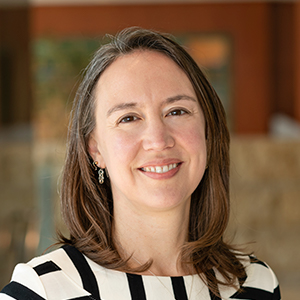At this point in the pandemic, experts estimate that more than 70 percent of the U.S. population has been infected with COVID-19. Some are unaware they were ever infected. Others, however, suffered symptoms for weeks and weeks … and weeks.
This is “long COVID,” a phenomenon identified early in the pandemic when people’s symptoms simply did not go away, or went away and then returned. According to surveys, the most common long COVID symptoms are fatigue, labored breathing, muscle aches and pains, cough, and cognitive dysfunction—a constellation that understandably may interfere with both quality of life and ability to work.

In the pandemic’s early days, former Minneapolis Fed Research Assistant Dasom Ham was studying how different surveys measure disability, and it struck her that individuals with long COVID might become eligible for disability insurance if their symptoms interfered with their work. This thought prompted her to start a new project to answer the questions, Does experiencing COVID symptoms for an extended time affect whether a person works? How much they work? How much they earn?
Because the data to answer these questions did not yet exist, Ham wrote four survey questions that were added to the May-June 2021 wave of the University of Southern California’s Understanding America Study, which regularly sends questionnaires to a representative sample of American households. This let Ham identify who had long COVID and who believed that their work was affected, as well as compare labor market outcomes among people who reported different COVID experiences.
Ham’s findings, presented in a new Opportunity & Inclusive Growth Institute working paper, are preliminary, but they suggest there is a group of “affected long-haulers” who are less likely to be employed and more likely to have changed their employment type than individuals who did not experience COVID the same way. In Ham’s study, a “long-hauler” refers to an individual whose COVID symptoms have lasted at least 12 weeks.
Now that the number of people who have had COVID is so large, the answers to Ham’s questions become all the more important. If long COVID is keeping people out of the labor force for the long term, that has implications for the Federal Reserve’s understanding of when we have reached maximum employment. It matters for how the government defines eligibility for disability insurance and how much income support long-COVID sufferers may need. And by impacting the workforce’s size and productivity, it might ultimately impact economic growth.
New survey for a new phenomenon
The main challenge for most analyses of COVID’s impact is having the right data to analyze. Institute Director Abigail Wozniak advocated early on for the robust real-time collection of data to understand where COVID was emerging and how people were faring.
For her analysis, Ham said, “The ideal data set would be something where you could track the same people over time, since it’s easier to calculate changes in labor market behavior if you can compare what they did before they had COVID to after they had COVID.”
Enter the Understanding America Study (UAS), which in 2013 started to provide researchers reliable, quick, and cost-effective data from a demographically diverse pool of people who respond to one or two surveys a month. When the COVID pandemic began, the UAS team launched a new, high-frequency survey aimed at better tracking and understanding the coronavirus’s impact across the country. Ham wrote questions (see Figure 1) that would allow her to categorize respondents according to their COVID status. These questions were fielded as part of a larger survey to about 4,900 respondents between May 12 and June 22, 2021.
| Question | Purpose |
|---|---|
| Since the start of the pandemic, have you ever become infected with COVID-19? | Identify individuals who have not had COVID |
| Did you have COVID-related symptoms or health complications that lasted at least 12 weeks? | Identify individuals who had COVID but not long COVID (non-long-haulers) |
| Did your COVID-related symptoms or health complications affect your employment status or work hours? | Identify individuals who had long-haul COVID that did not affect their work (unaffected long-haulers) and those who were affected (affected long-haulers) |
| Have you recovered from your COVID-related symptoms or health complications? If so, when did you recover? | Track individuals’ labor market status before and after they had COVID. |
These survey data give Ham two ways of evaluating long COVID’s employment impact. One, she can look at what people themselves say about how their COVID affected their work. And two, because the UAS surveys the same group of people repeatedly over time, Ham can categorize respondents according to their COVID status and then compare their actual work behavior before and after they got sick.
The relationship between health and employment
Ham’s first task is a simple one: Count how many people have had COVID, have had long COVID, and whose work has been affected by long COVID, by their own report. “To the best of my knowledge, I don’t think there were surveys at that time [2020–2021] in the U.S. that were specifically asking people, Is long COVID and the health complications related to it actually impacting you?” Ham explained.
Fortunately, her survey data do just that. Among respondents, about 13.4 percent reported they believed they had had COVID at some point. About a quarter of those who reported having COVID said they experienced long COVID, defined here as symptoms that lasted 12 or more weeks. And a quarter of these long-haulers said long COVID affected their employment status or work hours (see Figure 2).
These numbers are similar to the results of the U.S. Census Bureau’s June 2022 Household Pulse Survey, in which 19 percent of respondents who had experienced COVID said they were currently experiencing symptoms that had lasted three months or more. Applying these findings to the U.S. population as a whole, the Census’ survey results suggest 19 million adults living in the United States are currently experiencing symptoms of long COVID. Applying Ham’s findings, for about 4.8 million of them, their symptoms have affected their employment.
Long COVID is not going away.
Quantifying long COVID’s employment impact
Ham next looks at the labor market status before and after individuals experienced COVID as a way to quantify long COVID’s impact. The result is fairly striking, if unsurprising: Far fewer affected long-haulers remain employed after their bout with COVID than unaffected long-haulers and non-long-haulers (Figure 3). In addition, Ham looks at employment type—whether someone is self-employed or works for an employer. While more than 80 percent of unaffected long-haulers and non-long-haulers remained in the same employment type after they had COVID, only 66 percent of affected long-haulers did so. While more research is needed to better understand these changes in employment type, it suggests that some long-haulers need additional accommodations to keep working while they are suffering symptoms.
Ham also uses regression analysis to compare employment outcomes across groups so she can control for a variety of demographic factors, including age, education, race, gender, and marital status, that tend to be correlated with employment status, hours, and earnings. This is important to control for if a demographic factor is correlated with both having long COVID and with an employment outcome. For instance, women are more likely than men both to have long COVID and to have lower earnings.
Ham’s analysis suggests that for at least some individuals, there does appear to be a correlation between having long COVID and working less. First, Ham finds, during the time they are experiencing long COVID, affected long-haulers are 10 percentage points less likely to be employed than individuals who have not had COVID. Second, the change in hours worked in the past week is about 40 percent lower for affected long-haulers than it is for those who have not had COVID. Interestingly, there were no statistically significant differences in respondents’ last paycheck earnings regardless of their COVID status. While these findings may seem at odds at first, the survey questions Ham uses are not quite parallel: Respondents were asked for “work hours in the past seven days” and “most recent paycheck amount.” Additional survey data would help to better understand the specific labor market trajectories of individuals with different COVID statuses.
What we still don’t know—and why it matters
Ham believes that her findings should be viewed as preliminary and that more research on these questions is needed. The number of people with long COVID that her results are based on is fairly small, 193 in all. Furthermore, the job market was still in a great deal of flux in the spring of 2021. Unemployment had fallen a lot since it peaked in April 2020, but it was still close to 6 percent nationally. The share of Americans in the labor force remained a full two percentage points lower than its February 2020 value. (For context, at the height of the pandemic in April 2020, the percent of Americans in the labor force declined 3.1 percentage points.) Quits were at an all-time high and work-from-home arrangements were evolving.
That said, Ham is not alone in finding that long COVID adversely impacts some people’s ability to work. Survey results reported in the medical journal The Lancet in 2021 found that 45 percent of individuals who experienced long COVID had to work fewer hours, while another 22 percent were not working at all due to their illness. More recently, a National Bureau of Economic Research working paper by Gopi Shah Goda and Evan J. Soltas analyzing survey data from the Current Population Survey calculates a substantial increase in absences due to workers’ own illness during the COVID pandemic. The economists then calculate that workers with week-long work absences for their own illness during the pandemic are 7 percentage points less likely to be in the labor force one year after their absence than workers who did not have a health-related absence. Goda and Soltas estimate between 340,000 and 590,000 people have left the labor force between March 2020 and June 2022 due to deteriorating health related to COVID.
Future data collection and analysis will allow researchers to explore labor market outcomes among people with different demographic characteristics, such as age, education, or race. For instance, does the labor market impact vary with the age of the person experiencing long COVID? Goda and Soltas suggest yes, finding that it is mainly older workers aged 65 to 85 who leave the labor force in the year following a week-long health-related work absence. As poverty rates among the elderly increase in the United States, the long-term employment impact of long COVID on older Americans deserves more scrutiny.
Better data will also help us learn how to support the labor market participation of those who have been affected by COVID. A recent analysis from a research advisor at the New York Fed finds that the number of employed people who are disabled increased by about 900,000 during the last two years. Whether that trend continues may hinge on employers’ willingness to make workplace accommodations for those who need them.
Lisa Camner McKay is a senior writer with the Opportunity & Inclusive Growth Institute at the Minneapolis Fed. In this role, she creates content for diverse audiences in support of the Institute’s policy and research work.





